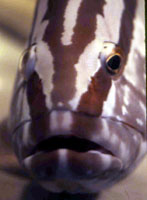
Hawai'i
Photo©CLCase

Wordlist #4: Populations
|
|
|
|
This fish is a K-strategist, the population fluctuates just under the carrying capacity of the pond. In 20 years, the population should be about 1450 fish. Unlike other known planets, Earth has sufficient natural capital to support life. Natural capital includes materials and energy, called natural resources, and natural services of purifying air and water and circulating chemicals necessary for life. Humans in areas with little natural capital such as the Gobi and Middle Eastern deserts remained nomadic into the mid 20th century, having to move to find food and grazing land. Historically, people settled down in areas rich with natural capital, such as in the Tigris, Euphrates, Nile, and Indus river valleys, because they could farm. Farming led to the ability to trade with other settlements. Some people became merchants while others farmed; the first cities developed about 6000 years ago. This pattern occurred worldwide. The Industrial Revolution led to the growth of cities as people emigrated from rural areas to work in factories. Prior to the 19th century, unemployed people lived at the edge of the city (sub urban). However, as transportation and water supplies improved, the wealthy could have larger homes on more land outside cities. The train first stimulated the development of suburbs around European cities. After World War II, in Europe and in the U.S., poor people migrated to cities for jobs. The automobile and the desire to escape the urban poor led affluent people to the suburbs. This affluence has led to high levels of consumption and unnecessary waste. In the U.S., since 1990, people have left both cities and suburbs looking for larger homes and more land in vast sprawling exurbs (extra urban). Exurbs are bedroom communities and most residents commute to jobs in urban areas some distance away. Affluent people have better access to medical care and education. They live longer and have lower infant mortality rates. In most affluent countries, the air and water are cleaner than they were in the 1970s and the food supply is abundant and safe. Affluence financed these improvements in environmental quality and education spurred citizens to insist that businesses and government improve environmental quality. However, the growth of low-density development on the edges of cities results in a hodgepodge of housing developments and shopping malls loosely connected by highways. The natural capital that originally led to development of a city—cropland, forests, and wetlands—is destroyed by construction. Unfortunately, the world's growth in affluence
is disproportionate to its natural capital and has brought with it a number
of unforeseen and unsustainable consequences
including global warming, depletion of nonrenewable resources, and an
ever-increasing ecological footprint. The ecological footprint measures
how much land and water area a human population requires to produce the
materials it consumes and to absorb its wastes using prevailing technology.
According to the United Nations, humans have
modified 50% of the Earth's land for agriculture, forestry, and housing.
The International Union for Conservation of Nature states that this habitat
loss is the primary cause of species extinction. Experts estimate that
we are losing 137 species daily and 50% of all species will be extinct
within 100 years because of habitat destruction. The rate of species extinction has increased
50% since the Industrial Revolution. A large number of species is critical
to sustainability because living species provide resources for the development
of new crops, drugs, and chemicals. Additionally, ecologists suspect that
decreased diversity destabilizes ecosystems and the natural services they
provide.
|